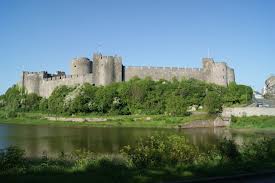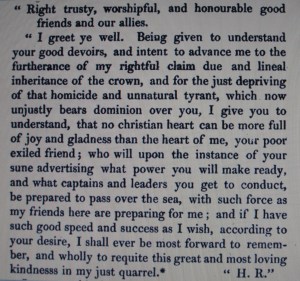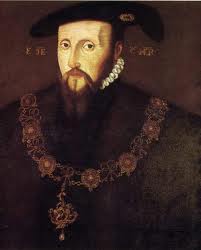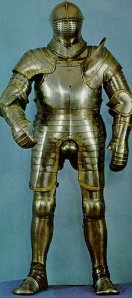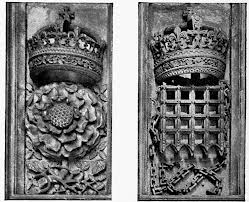Persona Non Grata
As a young man, the Earl of Richmond claimed that “from the time he was five years old he had been always a fugitive or a prisoner (Commynes 396-397). When Henry was just over four years old, Pembroke Castle, where he had lived with his mother and paternal uncle, Jasper Tudor, was overridden by William Herbert during a stage of the War of the Roses. Henry’s ward-ship was given to Herbert and he was raised along with the Herbert children at Raglan Castle. In fact, Anne Devereux , Herbert’s wife, held Henry’s affection throughout her life.
When William Herbert died in battle in 1469, following another stage of the War of the Roses and the return of the Lancastrians, Henry and Pembroke Castle were returned to Jasper Tudor. This time of stability was short-lived. By 1470 the Yorkist king, Edward IV, returned to power. It is not the purpose here to explain the minutiae of this civil war; let it suffice to say that it was expedient for Jasper and Henry to leave the country.
Intended for France, contrary winds blew them to Brittany (Often referred to as Bretagne) where Henry was to begin his 14-year exile as an enforced guest at the court of Francis II, Duke of Brittany (Griffiths, Hutchinson, Norton, Penn, Roberts, Vergil).

City of Vannes with the St.Peter Cathedral where Henry VII sent gifts in acknowledgement of his time there. He also depicted the city’s patron Saint, St. Vincent in his chapel in Westminster Abbey.
Because of the threats on his life and kidnapping plots, and the logistics of maintaining basically a refugee household, Henry was transferred from place to place. He was never truly settled. “Dependent on the whims of others, he learned to think like the fugitive he now was: to watch and assess loyalties, to sift information from rumour and, caught in the wash of European power politics, to understand how they affected his own fortunes” (Penn 4-5).

Chateau Lagoet’s Tour de Elven where Henry was kept between 1474-1476.

Chateau Vannes built by Francis II and visited several times by Henry.
His experiences certainly affected him. “He developed an exile’s patience, inured to a life in which stretches of empty time were punctuated by sudden alerts, moments of danger in which logical clear-headedness meant the difference between life and death” (Penn 5). He became resourceful, determined and “unabashed and unafraid when faced with adversity. He was capable of swift and decisive reactions, and yet he also learned the value of careful and detailed planning in order to avoid needless risks” (Griffiths168), all seemingly positive traits learned while under house arrest and exile. Some historians believe exile also created in Henry “an almost pathological suspicion” (Jones 61).
Regardless, Henry certainly impressed the French diplomat, Philippe Commynes who met him while he was in Brittany and France. Commynes marveled that Henry “without power, without money, without right … and without any reputation but what his person and deportment excited; for he had suffered much, been in distress all the days of his life, and particularly a prisoner in Bretagne to Duke Francis from the eighteenth year of his age who treated him as kindly as the necessity of his imprisonment would permit…” would emerge strong and noble (Commynes 560).

In the fifteenth century this gate in Vannes, Brittany was where Henry VII, as Earl of Richmond, passed into the city which protected other English expats.
In 1483 circumstances galvanized Henry to attempt an invasion of England; a pro-Lancastrian conspiracy, headed by the Duke of Buckingham, gained support in England; and Margaret Beaufort, Henry’s mother, began negotiations with the ex-Queen Elizabeth Woodville to marry their children (Henry to Elizabeth of York) to unite the Houses of York and Lancaster. After extensive preparations, several ships set sail toward Wales where Henry knew support would be the strongest and he could gain an entry point. After accompanying ships went astray, Henry “learnt the virtue of caution that day” (Griffiths102). Wisely, Henry returned to Brittany disappointed but not defeated.
About 10 months later, Henry was informed of a different sort of conspiracy which would have Brittany (under the leadership of Pierre Landais, chief advisor to an incapacitated Francis II) hand him over to Richard III. Henry organized his flight from the town of Vannes to France dressed as a groom with a small group of expats, he escaped across the border. Later when a recovering Francis II learned what had happened, he gave safe-conduct passage to the remaining retainers of Henry’s who were still in Brittany. This was a relief to Henry, who had a strong sense of obligation to those who shared his exile. Once in France, Henry obtained men and equipment from Charles VIII to launch an invasion of England in August of 1485 at the age of 28 (Griffiths, Hutchinson, Norton, Penn, Vergil, Roberts). The rest they say is history.
The impressions made on him from his years of exile affected more than just his personality. Henry VII was known for his preference for speaking French, his understanding of European politics and his unfamiliarity with English ways. Nevertheless, he was able to establish one of the most infamous ruling dynasties in England culminating in the rule of his granddaughter, Elizabeth Regina.
Unlike her grandfather, who had his mother and paternal uncle to direct him, Elizabeth had no such guidance and her apprenticeship to the throne was as severe as his had been. She too spent many years in a form of exile. She had to learn the art of statecraft and how to assimilate various players’ actions all while in seclusion at country houses with little or no contact with politicians both domestic or foreign.
She was able to create a strategy and with determination she maintained her course. This is not to say that she was inflexible. Elizabeth knew when to shift her course of action as her survival demanded it.
A religious book, The Epistles of St. Paul, owned by Elizabeth during the time that she was imprisoned by Queen Mary, has been preserved in the Bodleian Library. Amongst the passages she had designed was Vincit omnia pertinax virtus. E. C. In translation, Tenacious virtue conquers all* Elizabeth the Captive (Marshall 158, Nichols 11). Beyond her perseverance, her courage, cool headedness, self-reliance and self-possession were cemented during her removal from Court. Also forged during this time were several of her least attractive characteristics: her lack of candor, her ability to conceal her true intentions, her inability to trust, her extreme caution and her vacillation.

The Epistles of St. Paul preserved by the Bodleian Library showing the above mentioned phrase done in needlework by Elizabeth.
While Henry VII as Earl of Richmond spent 14 years in exile, Elizabeth experienced removal from Court several times. First was her self-imposed banishment to Hatfield after the Seymour troubles. She was barely 15 and she had the wisdom to rehabilitate her reputation by concentrating on running the estate, biding her time and minding her behavior. She led an exemplary life of scholarly pursuits in a decorous manner. She remained there when the Duke of Northumberland, using Lady Jane Grey as his figurehead, and Mary struggled for the throne. Once Mary was victorious, Elizabeth journeyed from Hatfield to offer congratulations and support (Erickson, Hibbert, MacCaffrey, Neale, Ridley).
As mentioned above, Elizabeth was detained by Queen Mary at Woodstock after the Wyatt Rebellion. This captivity, when Elizabeth was 21, was conducted differently from her grandfather’s escape to Brittany.
A letter preserved in the Talbot Papers from Robert Swift, steward to the Earl of Shrewsbury, reported on May 20, 1554,“Of Saterdaye, at one of the cloke at afternone, my Lady Elisabethe was delyv’ed out of Towre by the Lord Tresorer and my Lord Chamb’leyn, and went to Richemonde (on her way to the old Palace of Woodstock, where she remained in confinement till the end of April in the next year,) by water furthewy’er she landyd; wher she shal be attended upon by sundreye of garde, and some officers of ev’y office in the Quen’s howse, but how long she shall co’tinewe there I know not” (Nichols 8).
 Woodstock Palace drawn in 1714
Woodstock Palace drawn in 1714
Although her custodian, Sir Henry Bedingfield, a Privy Council member under Queen Mary, attempted to spirit her away it was not the case. People gathered to watch her pass, shouted support, offered her cakes and treats and rang the bells of their churches. The entire journey saw demonstrations favorable to Elizabeth to such an extent that at one point Bedingfield reminded their hosts along the route that Elizabeth was “a prisoner who had offended against the Queen” (Ridley 62). Once ensconced in Woodstock, Elizabeth knew her status as in the above reference to herself as ‘captive’ and also in the famous couplet she etched onto a window pane while at Woodstock when she signed herself as prisoner.
“Much suspected by me,
Nothing proved can be,
Quoth Elizabeth prisoner” (Nichols 9).
After almost a year’s confinement, Elizabeth was summoned to Hampton Court by orders directed to Sir Henry Bedingfeld by Queen Mary:
Hampton Court, April 17, 1555.
Trusty and well beloved, we greet you well. And forasmuch as we have resolved to have the Lady Elizabeth to repair nearer unto us, we do therefore pray and require you do declare unto her that our pleasure is she shall come to us to Hampton Court in your company with as much speed as you can have things in order for that purpose; wherein you shall not need to make any delay for calling of any other numbers than these, which are yourself and [those that] be now there attendant upon her, And of the time of your setting forward from thence, and by what day you shall think you may be there, we require you to advertise us by your letters with speed. Mary, the Queen (Mumby 187).
Sir Henry Bedingfield
Elizabeth spent time at Hampton Court and other houses from April 1555 until October when she returned to Hatfield. At Hatfield with her trusted servants, Elizabeth could still not feel safe as Mary had her under continual surveillance (Erickson 153). Eventually Mary’s suspicions eased, “there was something like a tacit truce between the two sisters. Elizabeth, withdrawn to country retirement at Hatfield…remained carefully aloof from all political activity. On both sides civility and decorum served to mask underlying unease” (MacCaffrey 25). It was here at Hatfield where Elizabeth learned of her ascension to the throne in November of 1558.
Works Cited
Commynes, Philippe de. The memoirs of Philip de Commines, Lord of Argenton: containing the histories of Louis XI and Charles VIII. Kings of France and of Charles the Bold, Duke of Burgundy. To which is added, The scandalous chronicle, or Secret history of Louis XI London: H. G. Bohn, 1855. Internet Archive, Web. 10 Feb. 2013. http://archive.org/details/historicalmemoi00comigoog
Erickson, Carolly. The First Elizabeth. New York: Summit Books. 1983. Print.
Griffiths, Ralph A. and Roger S. Thomas. The Making of the Tudor Dynasty. New
York: St. Martin’s Press, 1985. Print.
Hibbert, Christopher. The Virgin Queen: Elizabeth I, Genius of the Golden Age. New York: Addison-Wesley Publishing Company, Inc., 1991. Print.
Hutchinson, Robert. Young Henry: The Rise of Henry VIII. London: Weidenfeld &
Nicolson, 2011. Google Books. Web. 02 Dec. 2012.
Jones, Michael K. and Malcolm G. Underwood. The King’s Mother: Lady Margaret
Beaufort, Countess of Richmond and Derby. New York: Cambridge University Press, 1992. Print.
Marshall, Edward. The Early History of Woodstock Manor and Its Environs, in Bladon, Hensington, New Woodstock, Blenheim; with Later Notices:. Oxford: J. Parker and, 1873. Internet Archive. Web. 18 Feb. 2013.
MacCaffrey, Wallace. Elizabeth I. London: E. Arnold. 1993. Print.
Mumby, Frank Arthur, and Elizabeth. The Girlhood of Queen Elizabeth, a Narrative in Contemporary Letters, London: Constable, 1909. Internet Archive. Web. 19 Feb. 2013.
Neale, J. E. Queen Elizabeth I. Garden City, NY: Doubleday, 1957. Print.
Nichols, John. The Progresses and Public Processions of Queen Elizabeth. Among Which Are Interspersed Other Solemnities, Public Expenditures, and Remarkable Events during the Reign of That Illustrious Princess. Collected from Original MSS., Scarce Pamphlets, Corporation Records, Parochial Registers, &c., &c.: Illustrated with Historical Notes. New York: B. Franklin, 1823. Google Books. Web. 19 Jan. 2013.
Norton, Elizabeth. Margaret Beaufort: Mother of the Tudor Dynasty. Stroud: Amberley, 2010. Print.
Penn, Thomas. Winter King; the Dawn of Tudor England. New York: Penguin Books, 2012. Print.
“Queen Elizabeth, Her Progresses and Processions: Confinement of the Princess Elizabeth in the Tower–Her Removal to Woodstock.” The Saturday Magazine 21 Apr. 1838: 146-47. Google Books. Web. 18 Feb. 2013. <http://books.google.com/books?id=i1YFAAAAQAAJ&pg=PA145&dq=saturday+magazine+372&hl=en&sa=X&ei=yKEiUb_1LfGLyAHc1YCwBA&ved=0CDAQ6AEwAA#v=onepage&q=saturday%20magazine%20372&f=false>.
Ridley, Jasper. Elizabeth I: The Shrewdness of Virtue. New York: Fromm International Publishing Corporation, 1989. Print.
Roberts, Peter. “The Welshness of the Tudors.” History Today. History Today.com, n.d. Web. 11 Feb. 2013.
Vergil, Polydore. Polydore Vergil, Anglica Historia (1555 Version). Ed. Dana F. Sutton. Irvine: University of California, 2005. Polydore Vergil, Anglica Historia (1555 Version). The Philological Museum, 04 Aug. 2005. Web. 02 Jan. 2013.
For a reproduction of Queen Mary’s orders to Sir Henry Bedingfeld on his duties and responsibilities as keeper of the then Lady Elizabeth consult the digitized volume of The Girlhood of Queen Elizabeth: A Narrative in Contemporary Letters pages 135 & 135 at the following address: http://books.google.com/books?id=bpkQAAAAYAAJ&pg=PA134&dq=A+Memorial+given+by+the+Queen’s+Highness++unto+her+trusty+and+right+councillor&hl=en&sa=X&ei=p9ooUYOoC8XHrQGnyIGgDw&ved=0CDAQ6AEwAA#v=onepage&q=A%20Memorial%20given%20by%20the%20Queen’s%20Highness%20%20unto%20her%20trusty%20and%20right%20councillor&f=false
*Special thanks to Jamie, a Latin instructor, for her help with the translation of the quote by Elizabeth I.



